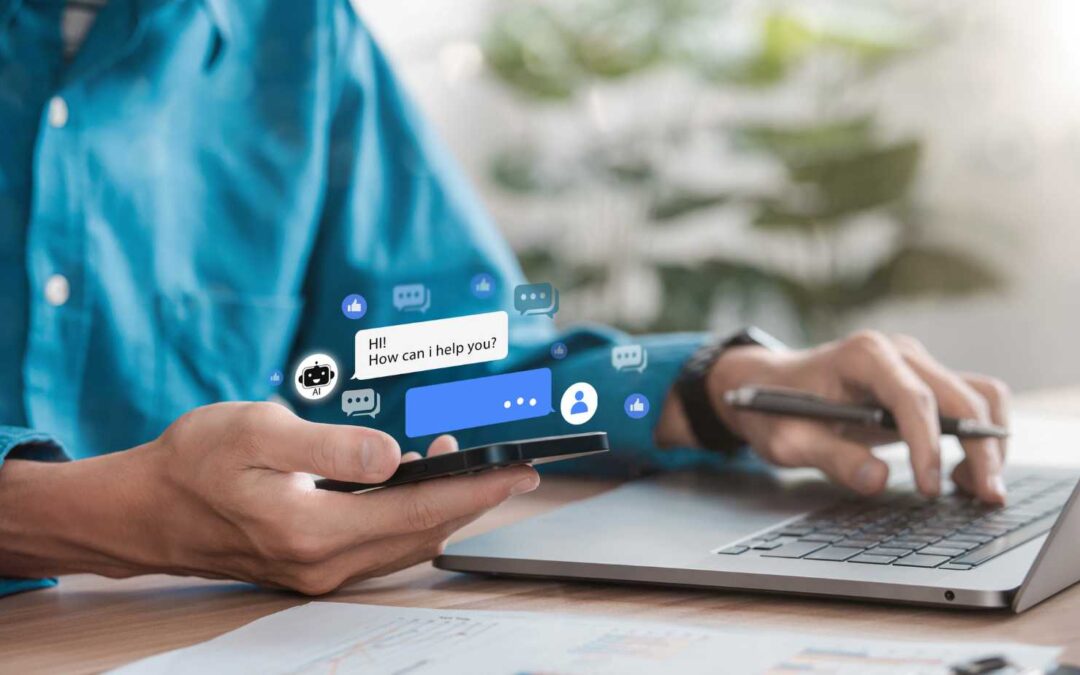In the world of ecommerce, a well-designed chatbot can be the cherry on top that elevates the customer experience to new heights.
As a savvy ecommerce business owner, you know that personalized product recommendations and quick customer service are essential components to keeping customers engaged and coming back for more. And a chatbot is one of the best ways to deliver this custom experience.
“If you make customers unhappy in the physical world, they might each tell 6 friends. If you make customers unhappy on the internet, they can each tell 6,000 friends.” —Jeff Bezos
Chatbots offer several benefits to ecommerce business. For instance:
- They can interact with thousands of customers all at once, around the clock.
- They automate several mundane and repetitive customer service tasks.
- They offer customers a more personalized shopping experience.
- They improve customer satisfaction and boost sales.
But how can you use them to gain new sales in your online store? Let’s look at three ways.
No. 1 – Personalized Product Recommendations
One effective way chatbots help generate new sales for ecommerce stores is delivering personalized product recommendations.
To do this, chatbots leverage customer data such as interests and past purchases. The result is that customers find products of interest that they otherwise might never have searched or in your store.
Take Sephora’s chatbot for instance, created in partnership with Kik Messenger to provide its customers with an engaging shopping experience.
Sephora is well-known for the vast array of products it offers, and through the chatbot, users can find makeup tutorials, skincare tips, and product reviews. Then, the chatbot helps them discover the products featured in the content and recommends the top-rated items for any category.

Sephora also has a Facebook chatbot that allows users to interact with the brand without ever leaving Facebook Messenger or talking to a live agent.
Right within the chat, users can browse new products, book appointments, and even see how makeup products will look on them through powerful AI filters.
With the customer information it gathers, the chatbot then lets people know about events, sales, and bookings that are relevant to the user and their location.
The level of engagement with the chatbot proves that people love interacting with it. It’s an immensely powerful marketing tool for Sephora.
By receiving personalized product recommendations from a chatbot, customers have an improved experience with the brand. It’s an added convenience for customers and lowers the friction involved in making a purchase.
Moreover, you can also design your chatbots to use customer data to tailor discounts and promotions to individual customers. This beats generic discounts and special offers because customers are far more likely to take advantage of a discount if it aligns with their interests.
And the same applies to loyalty programs.
Let’s consider an example of this in practice.
GearBunch is an American clothing company that specializes in products with unique patterns. In addition to leggings (its most popular product), it also offers other items such as yoga shorts, sports bras, and accessories.

Its chatbot—named Betty—was designed to assist with sales. It operates as a personal shopper, recommending products to users and stepping in when a prospect fails to convert. If, after all these steps, the customer still doesn’t make a purchase, Betty:
This re-engages customers who would otherwise be lost and persuades them to buy.
If, after all these steps, the customer still doesn’t convert, Betty:
- Offers discount coupons: Through the chatbot, GearBunch sends sale notices and discounts to customers to encourage them to buy. And seeing as 47% of millennial customers say that an exclusive offer will make them highly likely to buy, this tactic proves highly successful for the brand.
- Follows-up on abandoned carts: If a shopper adds a product to their cart but doesn’t complete making the purchase while shopping on the GearBunch website, Betty will send them a cart abandonment notification via Facebook Messenger with a link to their cart to complete the purchase.
With this chatbot, GearBunch has been able to increase its conversion rates by offering a personalized shopping experience and helping customers find the perfect product.
In all, chatbots can be an easy and convenient way for customers to browse and find the products they’re looking for. Often they can provide product information such as size and availability much more quickly than customers can find it on their own.
And, they can offer product suggestions for related products and alternatives to sold-out items.
No. 2 – Quick and Convenient Customer Service
The second way chatbots can help business gain new sales is by providing quick and convenient customer service around the clock. For instance, they can answer your customers’ most frequently asked questions accurately, consistently, and in real-time (that is, with an almost zero lead time between question and answer).
This is especially important as 90% of consumers expect an immediate response (that is, within 10 minutes) from brands with which hey interact.
Michael Kors’ chatbot is an excellent example of this. It not only provides existing deals and item suggestions but also FAQs, rerouting customers to a human agent should the need arise.

The chatbot contains answers to over 100 FAQs about various topics. Customers can learn more about the brand’s products and the bot can accurately answer the majority of customer queries.
The bot can also accept free-text questions or product searches (for example, a user might type in: “I want a purple blouse”) and it provides answers and highlights relevant products available on the brand’s website.
Additionally, the Micahel Kors chatbot provides a personalized gifting experience during the holiday season, solidifying its position as a key gifting destination.
People identify for whom they are shopping and what style they are looking for. Based on the answers, the chatbot displays products that match the requirements across various categories and price points.
Since its launch, the chatbot has garnered an enviable 375,000 total active users with an average of 45,000 new users added each month.
It boasts an average containment rate of 98.32%, which means that almost all users that enter the chatbot get satisfactory answers to their queries without being redirected to a customer service agent.
Other ways chatbots can deliver customer service are:
- Facilitate order tracking
- Deliver real-time updates on the status of customers’ orders, including shipping information and delivery times.
By keeping customers adequately informed in this manner, chatbots improve the overall store experience and reduce the number of calls and emails that customer-service representatives have to field on a daily basis.
No. 3 – Abandoned Cart Reminders
Another powerful way to use chatbots to generate ecommerce sales is to send abandoned cart reminders.
On average, cart abandonment rates sit at a whopping 69.99%. And, it is projected that in 2024 alone, ecommerce brands across the world will see up to $4 trillion worth of merchandise abandoned in digital carts.
Solving Cart abandonment issues is important and chatbots are an incredibly effective way to recover lost sales and prompt customers over the finish line.
As testimony to the effectiveness of abandoned cart reminders, Moosend—an email automation platform—found that 45% of all abandoned cart emails sent out to its customers were opened, 21% of those received click-throughs, and 50% of users who clicked through completed the purchase.
One example of an ecommerce company that uses a chatbot to send abandoned cart reminders to customers is American Eagle Outfitters.

Built on Facebook Messenger and Kik, the chatbot collects data on the customer’s browsing and purchasing habits before sending the message.
When a customer adds items to their cart but doesn’t complete the purchase, the bot dispatches an abandoned cart reminder. Each message is personalized based on the customer’s previous purchases and preferences.
For example, the chatbot might suggest complementary items or offer a discount to encourage the customer to complete the purchase.
Even after the message is sent, the chatbot continues to track the customer’s behavior and purchase decisions.
Overall, the use of a chatbot for abandoned cart reminders has proven to be a valuable tool for American Eagle Outfitters, helping to increase sales and engagement.
Chatbots Features
Before choosing a chatbot, develop a strategy and determine what features are most important to you. Then find one that meets your needs.
The table below shows different chatbot features:
With its affordability and ability to generate new sales through personalized product recommendations and high-quality customer service, a chatbot can be a game-changer for any online store.
Read the next article: Collecting Customer Data For Personalization

